|
Trees & Shrubs
Tree Types:
Fruit Trees
Japanese Maples Flowering Trees Shrub Types: Flowering
Shrubs Deciduous Shrubs Evergreen Shrubs Hedge
Shrubs
 Fruit Trees Fruit Trees
We have a great selection
of many fruit trees available. Most of these plants are very well-sized and ready to produce
fruit for you next season (some even have fruit on them now!) These are all great
trees for the local climate and are ready to start your home fruit "orchard".
We have both dwarf and mini dwarf apples for those smaller spaces, Bing,
Sweetheart and Rainier (sweet) and
Montmorency (sour) cherries, Apricot trees and Italian, Satsuma and Shiro
and Toka Plum trees. There
are
both European and Asian Combination Pears as well as espalliered apple and
pear trees. In the same area you will find wine grapes, a couple of varieties of table grape vines, several varieties of raspberries and lots
and lots of
blueberries.
This year we also have at least two varieties of producing figs for the
Seattle area - Stella and Desert King.
Japanese Maples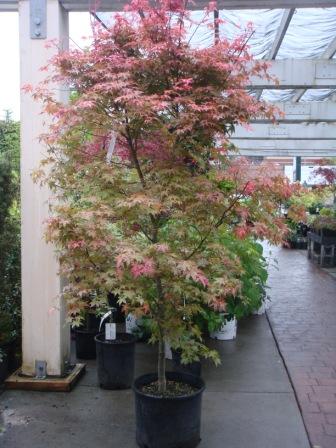
We have lots of
varieties of Japanese Maples to select from. Some of those are:
Twombly's Red (Pictured below), Shindeshojo
(pictured at right) "one of the most brilliant foliage plants..
Flaming scarlet (spring).. summer - reddish green... Fall colors become
blends of red and orange." Vertrees, Japanese Maples.
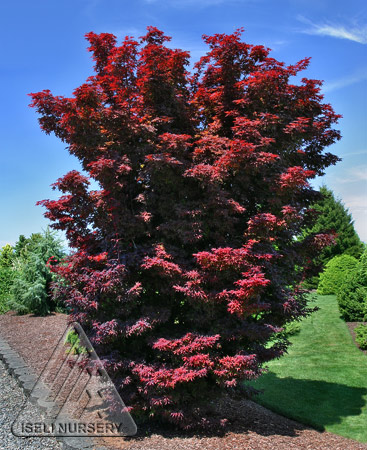
Sango kaku
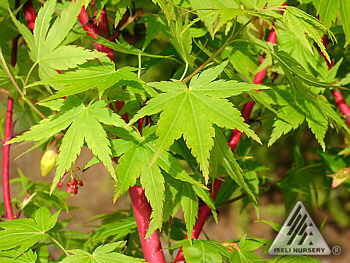 (Coral Bark Maple
pictured below right) (Coral Bark Maple
pictured below right)
The striking coral color of the stems and branches mark this tree as
something to light up a space. Especially good for spicing up a winter
garden.
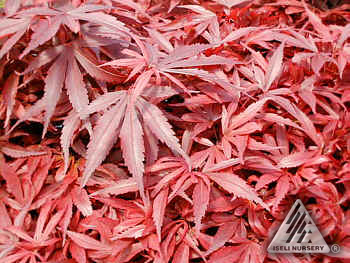
Shaina
Dark red to bright
red leaves (depending on sun exposure), dense and compact variety. Foliage
close to branches, great fall reds to oranges.
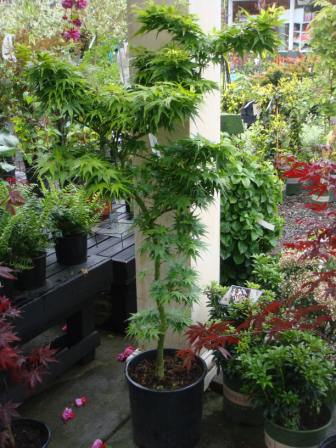
Mikawa yatsubusa
(pictured at left) Nice dwarf
variety. Pale green new leaves, light green when mature. Shoots and
quite short and leaf nodes very close together forming a dense coating of
leaves on each branch.
Butterfly (Kocho nishiki) A
variegated dwarf with shades of cream, green and pink (in the new growth),
the creamy areas take on a magenta color in the fall. Very striking.
Tamukeyama New spring foliage is crimson red turning to dark
purplish red in the summer and changing to bright scarlet red in the fall.
Noted for holding the dark color better than most other cultivars in the
Northwest. Currently available in both big and small sizes.
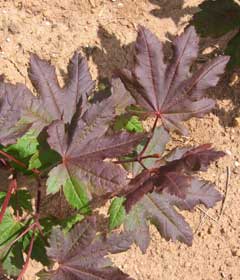 Pacific
Purple Vine Maple Pacific
Purple Vine Maple
Nice Specimens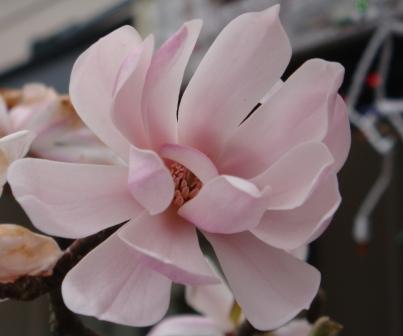
Beautiful larger trees include the Sourwood (Oxydendron) and the
Kobus Magnolia trees. These are 2"+ in trunk diameter, very nicely
shaped and ready to go into the ground or a larger container. The
Sourwoods are mostly now in bloom with their hummingbird attracting fragrant
lily-of-the-valley shaped flower clusters.
Kobus Magnolia
bloom
Magnolia "Little Gem"
A
great little tree for a Northwest setting, this evergreen tree is a perfect
choice for many locations. At its mature size it is usually no more
than 15 feet and can spread as wide if desired. If the spot you have
chosen for it is tighter than that, just keep it trimmed to a narrower
profile. These trees accept pruning and training quite well.
Some people train them as espaliers against a house or fence or they can be
kept columnar as a narrow specimen or as an accent in a larger setting.
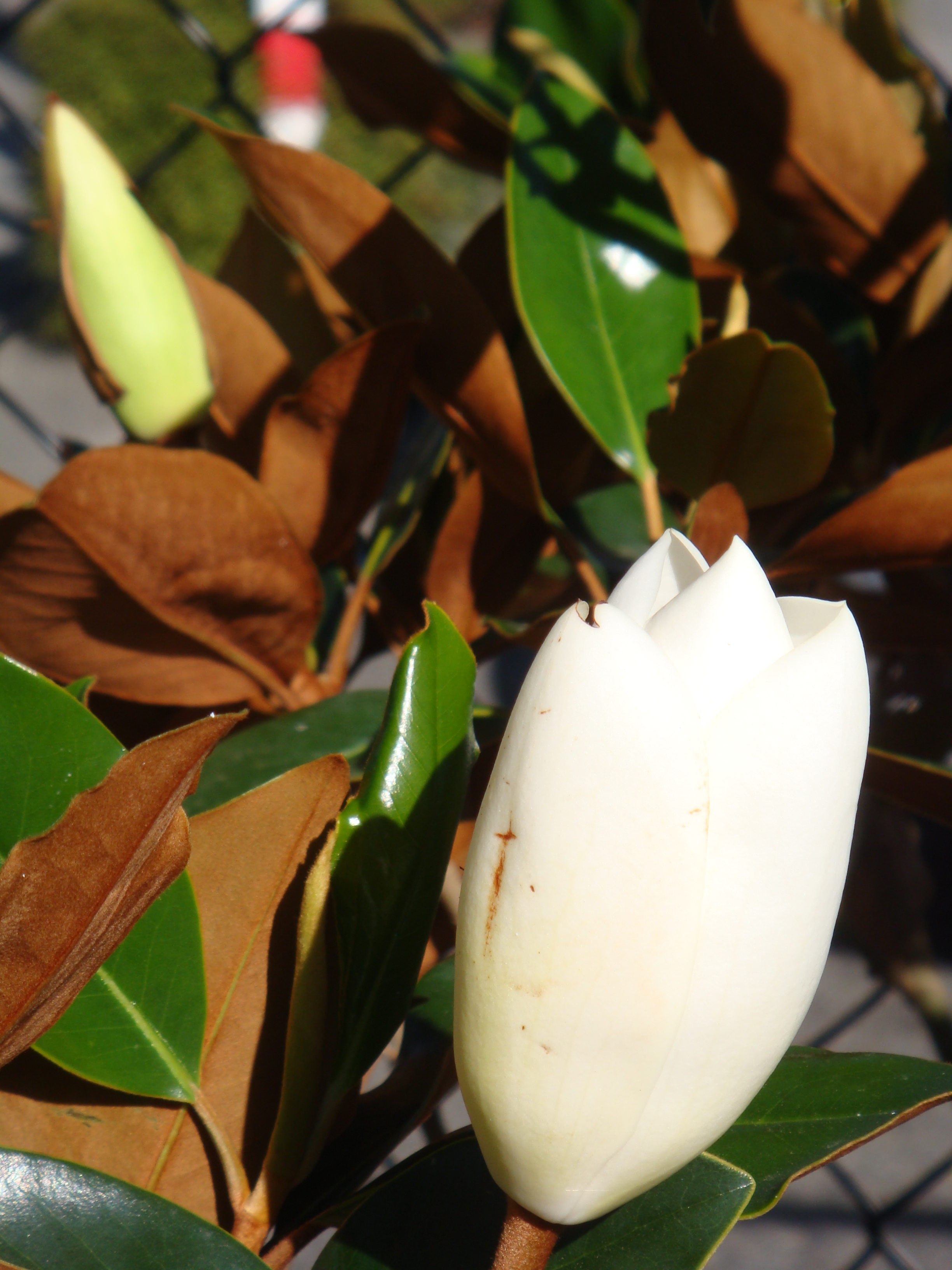 Beginning in spring Little Gem will
begin flowering and should keep producing their huge fragrant white flowers
even into winter. The fragrance is very floral, similar to gardenia
and wafts in the air when the flowers open. The new leaves are a
lustrous green with the typical brown indumentum on the reverse side. Beginning in spring Little Gem will
begin flowering and should keep producing their huge fragrant white flowers
even into winter. The fragrance is very floral, similar to gardenia
and wafts in the air when the flowers open. The new leaves are a
lustrous green with the typical brown indumentum on the reverse side.
The small
size of the leaves allows them to shed the occasional Northwest snow much
better than their larger evergreen Magnolia cousins resulting in a tree
nicely fit for our climate. We currently have trees already at 8 feet above the top of their containers.
Sourwood Tree
(Oxydendrum arboreum)
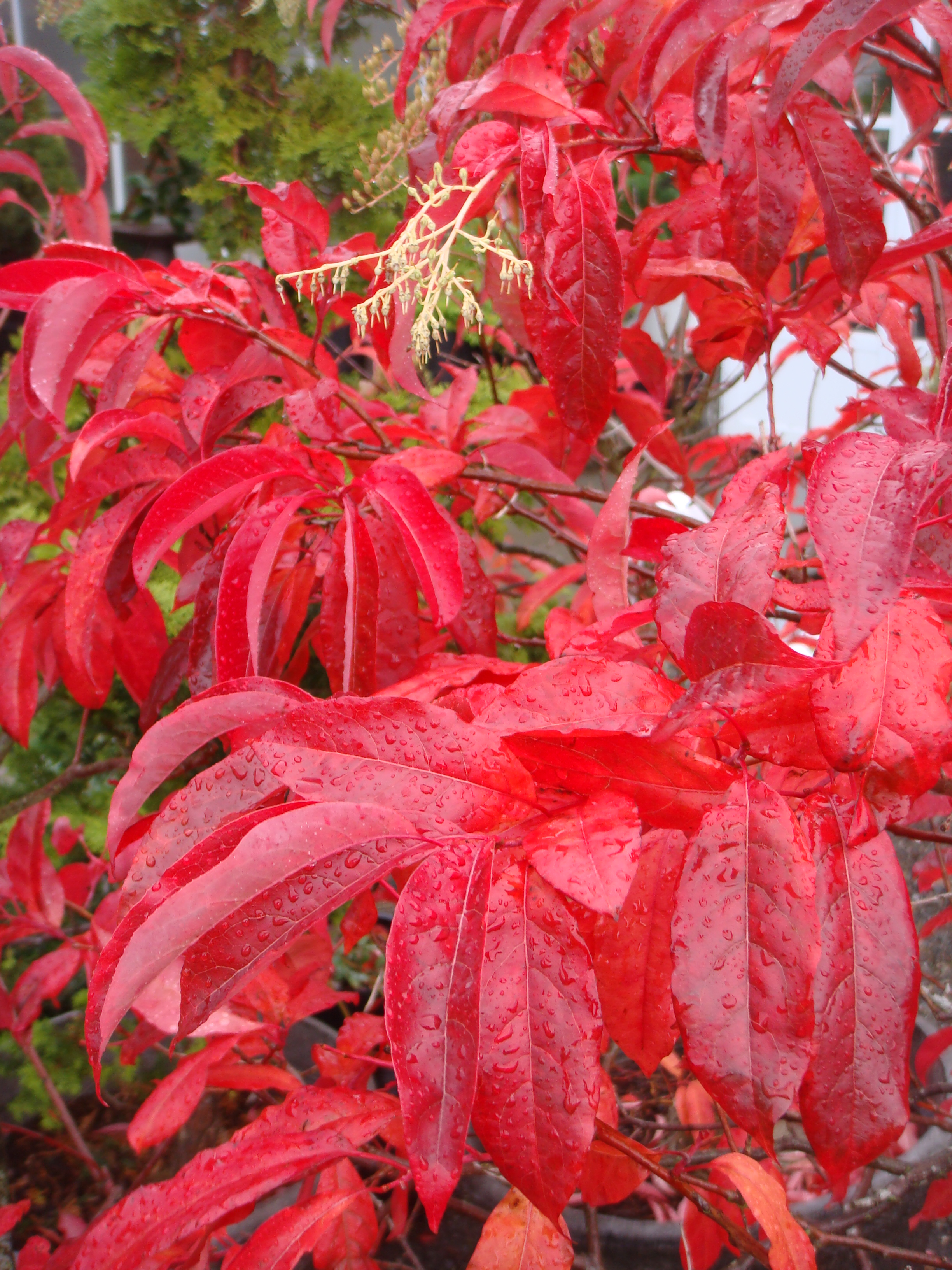
For spectacular fiery fall red colors try growing a Sourwood tree. We have a nice selection of Sourwoods - a great tree for many different
features throughout the year. New growth in the spring is touched with
bronzy red. The fragrant flowers trail in clusters remeniscent of
lily-of-the-valley flowers. The hummingbirds seem to love them for
their nectar and pollen. In the fall the leaves change from a lovely
green to a brilliant red. The flowers become seed pods hanging
gracefully in long finger-shaped groups and remaining through much of the
winter. Though it doesn't like to be underplanted with competing
plants, it is quite easy to grow in our area and has little problem with
disease or pests. They also make good container plants when they're
young.
Hydrangea Blooming Time
 One of the best plants for flowering
in the Northwest, the hydrangeas produce flowers incredibly easy here,
require little care and can be planted in a variety of settings. New
this year to the horticultural world is the large white petalled Great Star
Hydrangea (see picture below.) You
will also find the Endless Summer (usually blue in our area), Twist and Shout
(multi-color), Blushing Bride (white), nigra (pink flower with jet black
stems), City of Paris, City of Venice and City of Vienna (multi-colors), Limelight (chartreuse green), Annabelle
(large-headed white), larger-headed Incrediball (white), the Invincibelle
Spirit (pink) and several others including tree form types. Plant
Hydrangeas now for summer blooms next year. One of the best plants for flowering
in the Northwest, the hydrangeas produce flowers incredibly easy here,
require little care and can be planted in a variety of settings. New
this year to the horticultural world is the large white petalled Great Star
Hydrangea (see picture below.) You
will also find the Endless Summer (usually blue in our area), Twist and Shout
(multi-color), Blushing Bride (white), nigra (pink flower with jet black
stems), City of Paris, City of Venice and City of Vienna (multi-colors), Limelight (chartreuse green), Annabelle
(large-headed white), larger-headed Incrediball (white), the Invincibelle
Spirit (pink) and several others including tree form types. Plant
Hydrangeas now for summer blooms next year.
Great Star Hydrangea
If you have part shade or mostly shade
most of these will work for you. If you have mostly sun, several of
the above will work for you. When you come in tell us what conditions
you have so we can help you choose the best type for your garden space.
Vanilla Strawberry Hydrangea

A
tripple-dipped treat for your garden.
St. Paul, Minn. (Spring 2010)
offers triple the delight for hydrangea lovers.
This hydrangea paniculata’s enormous blooms
start out a creamy vanilla-white, changing to a
soft pink and finally to a ripe strawberry-red.
The unique red color lasts for three to four
weeks, longer than most hydrangeas of this
variety. New blooms keep the multicolored show
going throughout the summer and early fall.
The extra large blooms are held on strong,
red stems that cascade later in the season. It’s
upright habit and large cone-shaped flowers make
it a dramatic addition to the garden. It is
especially showy planted in groups in a border.
First Editions™ Vanilla Strawberry®
Hydrangea
Hydrangea paniculata 'Renhy' (PPAF)
Invinicibelle Spirit

"Finally - A pink flowered form of 'Annabelle' Hydrangea! As if
that wasn't exciting enough, it's a rebloomer, too! After years of
breeding, Dr. Tom Ranney and his team at North Carolina State broke the
color barrier. .....blooming with abundance every year in mid-summer
and continuing to produce new flowers right up until frost. We're not
talking about a few dissappointing flowers in later summer, but a sure fire
show of mop-head blooms on every stem."
Proven Winners
Incrediball Hydrangea
A new and improved 'Annabelle' Hydrangea, Incrediball has beefy
stems and massive blooms. The breeding goal was stronger stems to
eliminate flop. But we also got incredibly large blooms too!
Each bloom has roughly 4 times as many flowers as Annabelle!

Proven
Winners photos
For long
lasting bouquets, cut hydrangea flowers before they start to get their
winter color making sure to cut stems long enough to reach the bottom of the
vase. Place them in a vase with an inch or two of water in the bottom and
simply let the flowers drink up the water until the vase is dry. At
that point you should have dried hydrangea flowers that will last for many
months if not years!
Blue
Chip Butterfly Bush

"The first in a series of new miniature butterfly bush. Lo & Behold
Buddleia changes the way you think about butterfly bushes. Blue Chip is
a remarkable plant that blooms early and continuously without deadheading or
pruning. It can be used as a ground cover, low hedge or in containers.
Non-invasive." Proven Winners
Bloomerang
Lilac Currently sold out!
 
This new reblooming lilac rocks the horticultural world. The highly
fragrant flowers burst forth in spring and then again in mid-summer and
continue right up until frost. It has a compact, full growth habit and
small leaves that make it the perfect shrub for smaller gardens. Now
you can enjoy your lilac beyond two weeks in the spring! Mildew
resistant. - Proven Winners
Itoh Peonies
(Several varieties here now)

"If you admire the colorful exotic flowers of tree peonies but prefer the
perennial growing cycle of its herbaceous counterpart, Itoh peonies, also
know as Intersectional hybrids, are made for you.

In the quest to create a true yellow herbaceous peony, in 1948 breeder
Toichi Itoh was the first to successfully cross a tree peony with a
herbaceous selection. However, because these plants were slow to
multiply and expensive to produce, they were only available to a limited
market. This all changed in 2004 when a tissue culture laboratory
learned how to produce Itoh Peonies in vitro. .....
Itoh Peonies resemble tree peonies with a domed, vigorous growth habit
and large double flowers with disease-resistant lacy, dark green foliage.
They are winter dormant and grown exclusively in our Oregon nursery."
MONROVIA PLANTS
We stock several varieties including: Kopper Kettle and Pink Double
Dandy

Sasanqua camellias typically bloom late fall and early winter.
Japonica camellias usually bloom in the late winter and spring. We
have lots of sasanqua camellias to decorate your yard and feed
your hummingbirds at the same time! These fall and winter blooming
plants are a favorite of the overwintering Anna's Hummingbirds of our area.
We even have a dwarf variety that only grows to 2 or 3' in height.
Camellia sasanqua "Winter's Joy"
FRUITS & VEGETABLES
call for current availability
We have a great selection blueberry plants and several varieties of grape vines for your
spring planting
season. Varieties change so call for the latest varieties in stock
- Blueberrys - Sunshine Blue and Bountiful Blue evergreen (good
producers and year 'round ornamental as well!), Bluecrop, Chandler, Darrow,
Earliblue, Jersey, Liberty, Spartan and Patriot in sizes ranging from 6" pots to large ready to bear
plants.

-
-
- Raspberries - Toulameen, Amity and Fall Gold
- Grapes - Pinot Noir (wine grapes) out of stock,
Lakemont (red table), Himrod golden table grapes
- Rhubarb - Crimson Cherry - maintains its bright red color even
after cooking Now available as bare roots,
ready for planting
- Victoria - great for sauces and
pies
- Asparagus - Mary Washington - still some left
Early Start for Your Garden
Try starting your summer crops early with the help of plant
protecting fabric or season extending "Walls of Water". We carry
lightweight cloth often called "remay" (Harvest Guard) that can be put
directly over new tender plant starts. We
also sell plant protectors that are essentially bags that fit snuggly over
the entire plant. There is a new product ("Fleece Grow Tunnel")
that is 10' tube structure that will protect a line of plants or even pots.
These products can be used in the spring to help get
your vegetable plants off to an early
start. If you have more questions come on in or call and we will see if we have
something that can help.
SHRUBS
What would the garden be without fragrance? We have many shrubs with fragrant
winter or spring flowers.
- Sweet box - Sarcoccoca
- Winter Daphne - Daphne odora marginata and Daphne Eternal Fragrance
- Mock Orange - Philadelphus 'Belle Etoile'
- Lilacs - Lots of incredibly fragrant plants to choose from
Wonderful Evergreens
- Hebes - Alicia Amherst, Blue Mist, Buxifolia "nana", Red Edge,
Topiaria, Purple Leaf,
- Parahebes - great low growing, all summer bloomer
- Rhododendrons - Rangoon, Edith Bosley, Scarlet Wonder, Hello Dolly
- Azaleas
- Ceanothus - several varieties of this tough plant. Great for sunny
spots
- Barberries - both red and golden forms, another sunlover
- Pieris - Prelude, Cavatine, Flaming Silver
- Compact Strawberry Tree, Arbutus unedo 'Compacta' and its
taller relative Arbutus marina
- Mexican Mock Orange - Sundance and the straight species (ternata)
Hedge Plants _ If you're planning on installing a hedge,
check with us for
ideas and specifications. If you want to go further we can order what
you need and can even plant them for you. The following are some of
the plants we suggest for hedges in the Northwest:
- Emerald Green Arborvitae
- English Boxwood 6" and 8" pots sizes
- Northern Beauty Japanese Holly
- Ilex crenata convexa Japanese Holly
- Escallonia including dwarf types
- Mock Orange and Mexican Orange varieties
- Viburnum "Spirit"
- Irish Yew
- Bamboo
- Wax-leafed Privet
- Ceanothus Victoria
- Barberry (for a low growing hedge try Crimson Pygmy)
The Tropical Look
- Prickly Pear Cactus - winter hardy for much of Seattle
blooming now!
- Gardenia 'Kleims Hardy' new plants now here
- Yucca Color Guard
- New Zealand Flax
- Cordyline
- Canna Lillies sold out
- Agapanthus Storm Cloud
Huge 5 gallons now blooming!
- Star Jasmine new plants to choose from
VINES
- Star Jasmine
- Evergreen Clematis - C. armandii, and Early Sensation
- Clematis - Deciduous varieties
- Climbing Hydrangea
- Wisteria
- Akebia
- Boston Ivy
- Golden Hops
- Grape - ornamental or fruiting
Insects and Disease
Leaf damage
Many insects damage plants by
chewing the leaves, buds, flowers or stems. Often the type of damage
is clearly the work of a specific kind of insect. Notched leaves, for
example, are usually the work of root weevils. Fortunately there are
good solutions for prevention that do not involve toxic chemicals. The
best is the use of barriers that trap the destructive bugs.

|
|
Tangle-Trap Insect Trap Coating & Tree Tanglefoot Pest Barrier
 These
Barriers are effective against crawling insects who must reach the
tops of trees in order to feed, mate, or deposit eggs. Such insects
include cankerworms, gypsy moth caterpillars, army and tent
caterpillars, ants, obscure root weevils and pecan weevils, tussock
moths and climbing cutworms. Some of these insects are wingless
females. Some of these insects are wingless females. Some may have
wings but do not fly. It is a part of their life cycle that they
crawl up the trunks of trees to mate and deposit eggs. And others of
these insects simply crawl up the trees to feed on their buds,
leaves and fruit, consequently devastating the tree. These
Barriers are effective against crawling insects who must reach the
tops of trees in order to feed, mate, or deposit eggs. Such insects
include cankerworms, gypsy moth caterpillars, army and tent
caterpillars, ants, obscure root weevils and pecan weevils, tussock
moths and climbing cutworms. Some of these insects are wingless
females. Some of these insects are wingless females. Some may have
wings but do not fly. It is a part of their life cycle that they
crawl up the trunks of trees to mate and deposit eggs. And others of
these insects simply crawl up the trees to feed on their buds,
leaves and fruit, consequently devastating the tree.
 Pest
Barriers provide the perfect solution to protecting your valuable
trees and reducing future populations of these pests. As the insects
climb up over the sticky material, they become trapped without
escape. Pest
Barriers provide the perfect solution to protecting your valuable
trees and reducing future populations of these pests. As the insects
climb up over the sticky material, they become trapped without
escape.
 Best
of all, the action is strictly mechanical --no pesticides or harmful
chemicals are involved. Best
of all, the action is strictly mechanical --no pesticides or harmful
chemicals are involved.
Keep Ants off Hummingbird Feeders
Use pest barriers at
the base of bird feeder hanging stands to prevent ants from climbing
onto the feeders. Be careful to avoid getting barrier material
on the top part of the feeder hanger or anywhere birds might perch.
In hot weather reapply the material every few weeks to refresh its
effectiveness.
 Tanglefoot
and Tangle-Trap Pest Barriers: Tanglefoot
and Tangle-Trap Pest Barriers:
- Provide long lasting, all weather protection
- Is formulated for both home and professional use
- Tanglefoot contains all natural ingredients
- Can be used alternately for both hot and cold seasons
Tangle-Trap Insect Trap Coating - Brush-On Formula 8oz. with
brush in can.
$7.99
Tree Tanglefoot Pest Barrier - 6 Oz. tube
$6.99
 Prices do not include shipping. Call or
email today to order.
Prices do not include shipping. Call or
email today to order.
|
| |
|
|
Questions about our trees and shrubs?
Email
Chuck! Looking for something in particular? We take special orders. Just call us! Don't know what you want? Just stop by and we can help!
|

 Fruit Trees
Fruit Trees

 (Coral Bark Maple
pictured below right)
(Coral Bark Maple
pictured below right)

 Pacific
Purple Vine Maple
Pacific
Purple Vine Maple One of the best plants for flowering
in the Northwest, the
One of the best plants for flowering
in the Northwest, the







